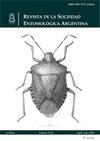苏云金芽孢杆菌(芽胞杆菌科)和金龟子绿僵菌(芽胞杆菌科)对小天鹅的防效研究
IF 0.5
4区 农林科学
Q4 ENTOMOLOGY
引用次数: 0
摘要
由于其隐蔽的觅食行为,大多数合成杀虫剂对赤眼鸡(Swinhoe)的药效都受到了影响,因此迫切需要找到其他环保的有效管理方法来对抗这种臭名昭著的害虫。在控制条件下,评估了C.partellus 2龄和4龄幼虫对苏云金芽孢杆菌(Bt-k)(Berliner)和绿僵菌(Mechnikov)的敏感性。幼虫采用单一剂量率的苏云金芽孢杆菌(Bt:0.75µg/g)和三种分生孢子浓度(1x104、1x106和1x108分生孢子/ml)的M.anisopliae单独或联合处理。两种昆虫病原体的单独应用和联合应用显著影响了C.partellus两个幼虫龄的死亡率、化蛹、成虫羽化、真菌病和孢子形成。绿脓杆菌(1x108分生孢子/ml)和苏云金芽孢杆菌(0.75µg/g)的联合应用记录了最大幼虫死亡率(2龄:94.63%,4龄:91.43%)。与其他实验处理相比,相同的综合处理也导致了C.partellus的化蛹率(第二次:0.00%和第四次:6.66%)和成虫羽化率(第三次:0.00%-第四次)的显著下降。此外,当暴露于较低的个体浓度(1×104分生孢子/ml)时,两个幼虫龄(2龄:88.52%和143.96分生孢子/ml)和(4龄:82.04%和131.85分生孢子/mml)的真菌病和孢子形成率都显著较高。目前的研究结果表明,绿僵菌和苏云金芽孢的综合应用可能是一种可持续的玉米种植管理工具。本文章由计算机程序翻译,如有差异,请以英文原文为准。
Bio-control potential of Bacillus thuringiensis (Bacillales: Bacillaceae) and Metarhizium anisopliae (Hypocreales: Clavicipitaceae) against Chilo partellus Swinhoe (Lepidoptera: Pyralidae)
The efficacy of most synthetic insecticides has been compromised against Chilo partellus (Swinhoe) due to its cryptic feeding behavior, hence there is a dire need to find other eco-friendly effective management approaches to combat this notorious pest. The susceptibility of 2nd and 4th larval instars of C. partellus was assessed against Bacillus thuringiensis var. kurstaki (Bt-k) (Berliner) and Metarhizium anisopliae (Mechnikov) under controlled conditions. The larvae were treated with individual or combined treatments of a single dose rate of B. thuringiensis (Bt: 0.75 µg/g) and three conidial concentrations (1x104, 1x106 and 1x108 conidia/ml) of M. anisopliae. The individual and combined application of both entomopathogens significantly affected the mortality, pupation, adult emergence, mycosis and sporulation of both larval instars of C. partellus. Maximum larval mortality (2nd instar: 94.63% and 4th instar: 91.43%) was recorded in combined applications of M. anisopliae (1x108 conidia/ml) and B. thuringiensis (0.75 µg/g). The same integrated treatment also caused significant declines in pupation (2nd: 0.00% and 4th: 6.66%) and adult emergence (2nd: 0.00% and 4th: 0.00%) of C. partellus as compared to rest of the experimental treatments. Moreover, a significantly higher rate of mycosis and sporulation were recorded in both larval instars (2nd: 88.52% and 143.96 conidia/ml) and (4th: 82.04% and 131.85 conidia/ml), when exposed to lower individual concentration of M. anisopliae (1×104 conidia/ml). The current results suggest that integrated application of M. anisopliae and B. thuringiensis could be a sustainable management tool for C. partellus in maize crop.
求助全文
通过发布文献求助,成功后即可免费获取论文全文。
去求助
来源期刊

Revista De La Sociedad Entomologica Argentina
Agricultural and Biological Sciences-Insect Science
CiteScore
0.80
自引率
20.00%
发文量
31
审稿时长
20 weeks
 求助内容:
求助内容: 应助结果提醒方式:
应助结果提醒方式:


